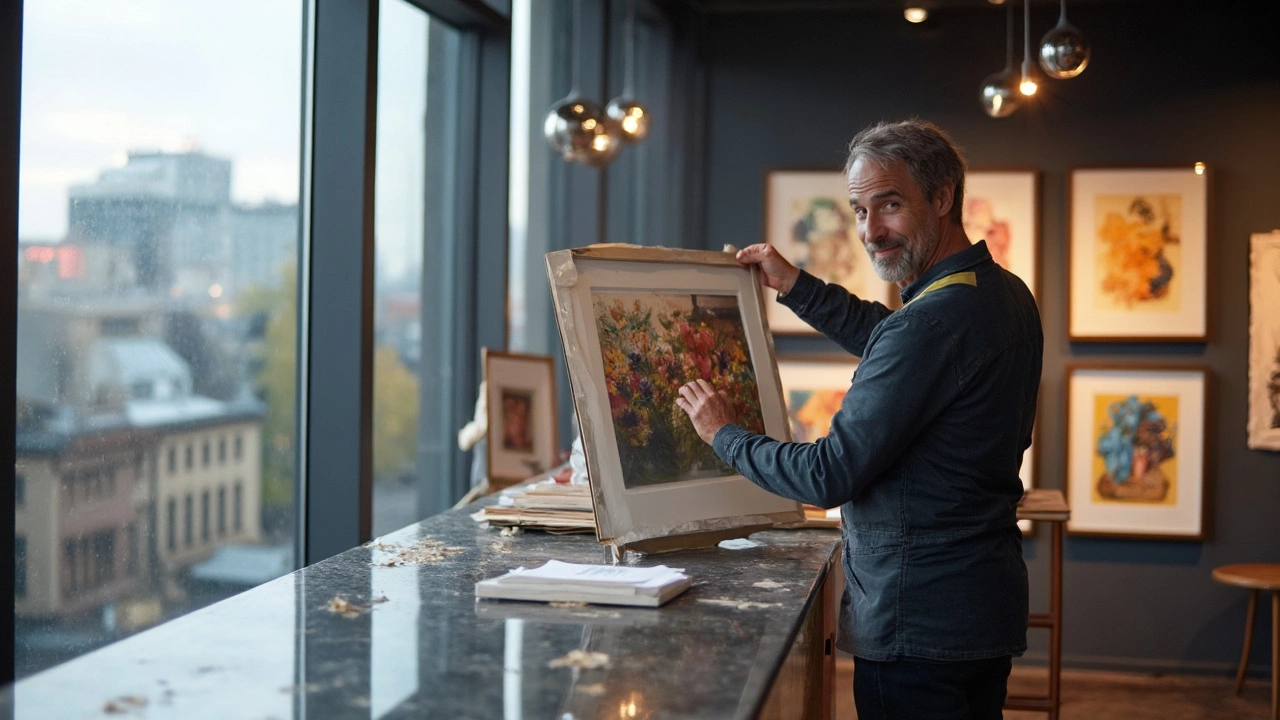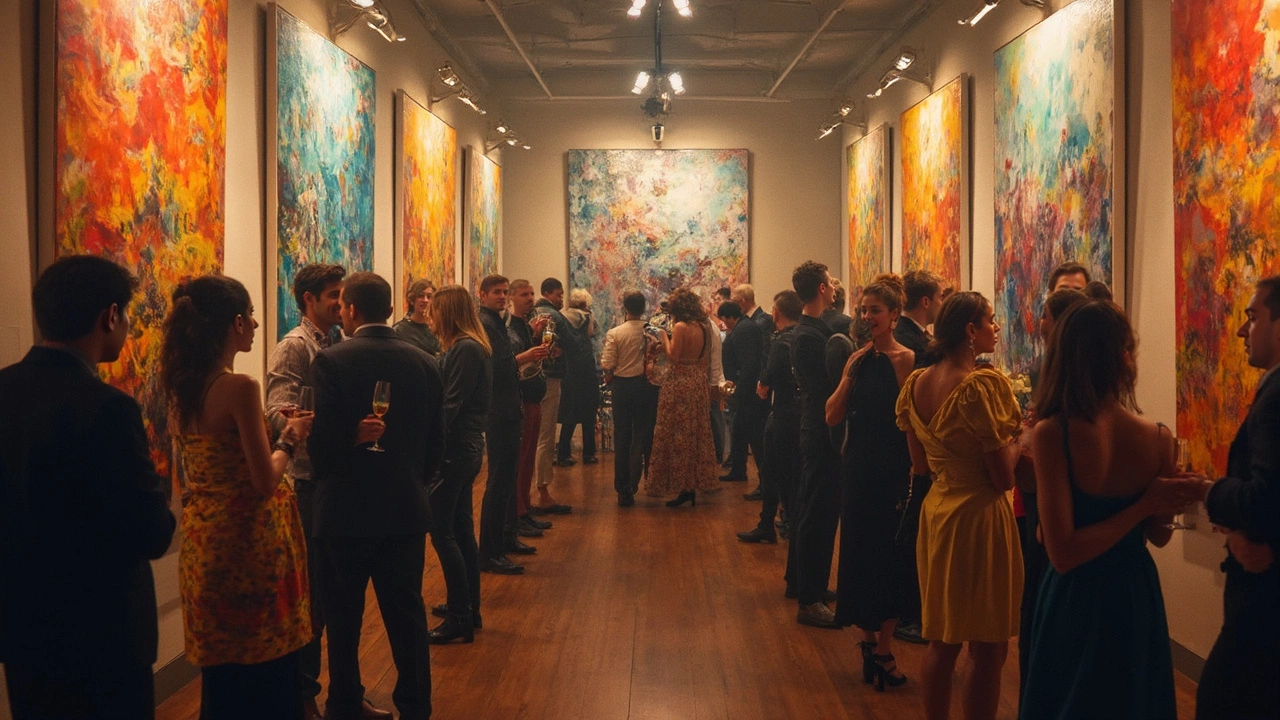So, you're thinking about showcasing your masterpieces in a solo exhibition? That's exciting! Let's be honest, going solo can feel a tad overwhelming, but it's also a fantastic way to connect with art lovers and share your vision—or just to see those eyes twinkle with admiration for your work.
The first biggie? Picking a venue. You'll want a space that vibes with your style and accommodates your needs. Whether it's a local gallery, a cafe with personality, or even something unconventional like a pop-up in an empty storefront, make sure it's accessible and appealing.
Don't forget the budget—money matters. Be realistic about what you can afford, from venue rent to framing costs. It's not just about where, but how your art will be displayed, so think about all those extras that give a polished finish.
- Choosing the Right Venue
- Setting a Realistic Budget
- Crafting Your Artist Statement
- Planning the Layout
- Promoting Your Exhibition
- Engaging with the Audience
Choosing the Right Venue
Alright, so the first step to planning your solo art exhibition is finding that ideal venue. It’s kind of like finding the perfect outfit—it’s got to look good and feel right for what you’re showcasing. Venues can vary from your friendly neighborhood art gallery to a trendy loft. It must match the vibe of your artwork and attract the kind of audience you’re looking for.
The easiest way to narrow down your options is by considering a few key factors:
- Location, Location, Location: Go for a spot that's easy to reach and is in a place where people actually go—trust me, convenience can be everything when attracting more foot traffic.
- Size Matters: Think about how many pieces you plan to display and if the venue can comfortably accommodate them without feeling cramped. You don’t want your art to bump elbows, right?
- Facilities and Features: Does the space have proper lighting? Wall space? Accessibility for guests? These might seem small, but they can make a big difference in how your work is viewed.
- Cost Consideration: Stick to your budget. Consider all the costs involved, like rental fees, insurance, and any additional hidden charges. Better to know upfront than be caught off guard.
- Cultural Fit: Does the venue usually host art similar in style or type to yours? The venue should naturally draw in the crowd who'd appreciate your art.
And a little pro tip: Talk to fellow artists who’ve had their art exhibitions in places you’re considering. Real-world feedback is gold. Also, sometimes stepping off the beaten path and considering less traditional venues can lead to unexpected awesome experiences!
Setting a Realistic Budget
Diving headfirst into a solo art exhibition can quickly become a money pit if you're not careful with planning your finances. Let's take a closer look at how to balance dreams with dollars without breaking the bank.
First, jot down every possible expense—seriously, don't miss a thing. This includes venue rental fees, art supplies, framing costs, installation materials, promotional expenses like flyers and social media ads, and don't forget the opening night snacks and drinks! A good rule of thumb is to overestimate a bit—it's better to have a little extra cash set aside than to come up short.
You might be surprised, but venues can account for a significant chunk of your budget. According to Creative Boom, 'On average, gallery charges for a solo show can range from $500 to $2,000 depending on location and size.' With this in mind, make sure to pick a place that aligns with your budget without sacrificing style.
Craig Bunting, an experienced gallery owner, once said, "Understanding the dynamics of your budget is just as important as understanding your art's message. A smart budget can make or break your exhibition."
Once you've got a number in mind, it’s time to think about where you might save. Can you DIY any decor? Can a friend help with the catering, or can you do a digital invite rather than print? Creative solutions can stretch your budget further than you'd think!
Here's a quick guide to help you cover your bases:
- Venue Hire: Scout locations that offer package deals.
- Art Supplies and Framing: Look for bulk discounts or local suppliers.
- Promotion: Utilize free press release sites and leverage social media like Instagram for maximum buzz.
- Insurance: Protect your art—don't skip here.
- Catering: Opt for simple, popular choices within budget.
Remember, it's all about balancing creativity with cash flow. The clearer you are on your financial limits, the more freedom you'll have to focus on what really matters: sharing your incredible work with the world.
Crafting Your Artist Statement
Alright, let's talk about your artist statement. This is your chance to let people peek into your creative mind. It explains what your art is about, the themes you explore, and maybe a bit about your process. It's like the story behind your work, and trust me, readers love a good story!
Your statement should be short and sweet—aim for a couple of paragraphs. Think of it as the chat you'd have with someone interested in your art at your show. Keep it friendly and use first person. Talk about why you create, what you're trying to express, and maybe touch on any inspirations. Steer clear of too much jargon; not everyone speaks 'art-ese.’
Here's a tip: Start by brainstorming. Jot down a few points that highlight your art journey, challenges you've faced, or unique things about your style. Then, craft these into a narrative that connects your pieces. Imagine yourself explaining your work to a friend over coffee—simple, right?
For those who geek out on structure, here's a simple way to get it done:
- Introduction: Start with a hook or a sentence that captures the essence of your work.
- Body: Dive into your themes, mediums, and your philosophy as an artist. This is where the magic happens.
- Conclusion: Wrap it up by circling back to your core ideas and leaving the reader with something to think about.
Need some inspiration? Look up statements by artists you admire. Notice how their personality shines through? Emulate that approach. And remember, just be yourself—honesty in your artist statement can be as compelling as the art itself.

Planning the Layout
Alright, once you've got your venue sorted, it's time to think about how your art will be displayed. This can make a huge difference in how people experience your work. You don't want visitors bouncing from piece to piece in confusion. It should feel natural and intuitive.
First, measure the space and know exactly what you're working with. This isn't just about fitting paintings on walls – you need to think about how people will move around. Space them out so there's room to step back and really take in each piece.
Grouping is key. Consider creating some kind of flow by placing paintings or sculptures that relate to each other close by. This could be by theme, color, or even mood. But avoid placing similar-sized artworks next to each other; it might end up looking too uniform.
Lighting matters more than you might think. It can make or break how your artwork looks. Natural light is wonderful, but not always reliable. Consider using track lighting or spotlights to highlight key pieces. Remember, no harsh glares – you want the colors to pop, not sizzle!
- Entrance Piece: Place a striking piece at the entrance to set the theme and draw in the crowd.
- Center of Room: Use the middle area for pieces people might spend longer admiring.
- Eye Line: Keep works at eye level (about 57 inches from the floor to the center of the artwork).
In terms of physical layout, think about intentional breaks or resting spots where visitors can pause. This not only avoids traffic jams but allows people to digest what they've seen so far.
Lastly, test your layout before the big day. Invite friends over for a mock tour. Their feedback can be invaluable in tweaking things for better flow and engagement. Remember, the goal is to make your solo art exhibition an immersive, enjoyable experience for everyone who walks through.
Promoting Your Exhibition
Alright, so you've got your venue sorted and your artwork is prepped! Now, the next big step is getting the word out. Promoting your solo art exhibition effectively can make a world of difference in ensuring you have an audience that appreciates what you do.
First off, social media is your friend. Platforms like Instagram and Facebook are perfect for reaching art lovers. Share sneak peeks of your art, and behind-the-scenes prep, and create an event page that keeps people updated on details. Use relevant hashtags to boost your visibility—like #ArtExhibition or #SoloArtShow. It's where you can let your personality shine and engage directly with potential visitors.
If you're thinking old school, you might want to consider posters and flyers, especially if your venue is local. Visit cafes, bookstores, and community centers. Talk to the owners and see if they'll let you display some. It's amazing how a simple, visually attractive flyer can catch the eye.
“Effective promotion is not just about getting people to see your art, but encouraging them to engage and connect with it,” says Maria Popova, a renowned art critic.
Don't skip email! These days, emails aren't out of style—they're just as potent as ever. Compile a list of contacts including art critics, local journalists, and past buyers who might be interested. Create a short, compelling invitation and shoot it out a couple of weeks before the exhibition.
For those who love a bit of good old-fashioned data, consider this: According to a survey, exhibitions promoted on both social media and email can experience attendance rates that are up to 30% higher than those that rely solely on word of mouth. Here's a quick look at the findings:
| Promotion Method | Average Attendance Increase |
|---|---|
| Social Media & Email | 30% |
| Social Media Only | 15% |
| Email Only | 10% |
Finally, don't forget to interact with local newspapers or art blogs for a write-up or an interview. They can help amplify your exhibition's reach.
By mixing both digital and traditional promotion techniques, you're setting yourself up for a successful and perhaps even memorable art exhibition. And who knows? Maybe a local gallery catches wind and decides to feature your work next!
Engaging with the Audience
Engaging your audience is a game-changer when it comes to a solo art exhibition. It's not just about showing your pieces; it's about creating a memorable experience for the people stepping into your world.
First up, consider hosting an artist talk. Sharing the stories behind your works and the process involved can deepen the connection between you and the viewers. It’s not just about selling art; it’s about selling an experience. A recent survey found that 68% of gallery visitors enjoy art more when they understand the artist’s perspective. Think of it as inviting them into your headspace.
"Connecting with your audience in an authentic way is vital for leaving a lasting impression," suggests Sarah Green, Director of the Wellington Art Museum.
Having interactive elements can also spice things up. Maybe set up a live painting session or a collaborative artwork where visitors can add their touch. Not only does this involve them directly, but it's also something they'll remember long after leaving.
Don't forget social media! Encourage visitors to snap photos and share them using a unique hashtag. This not only spreads the word but creates a buzz around your exhibit artwork. Plus, live-streaming parts of your exhibit can reach a wider audience who can't be physically present.
Finally, consider offering small workshops or Q&A sessions throughout the exhibition. These opportunities help people dig deeper into your process and offer them a chance to interact directly with you, making your exhibition more personal and memorable.

